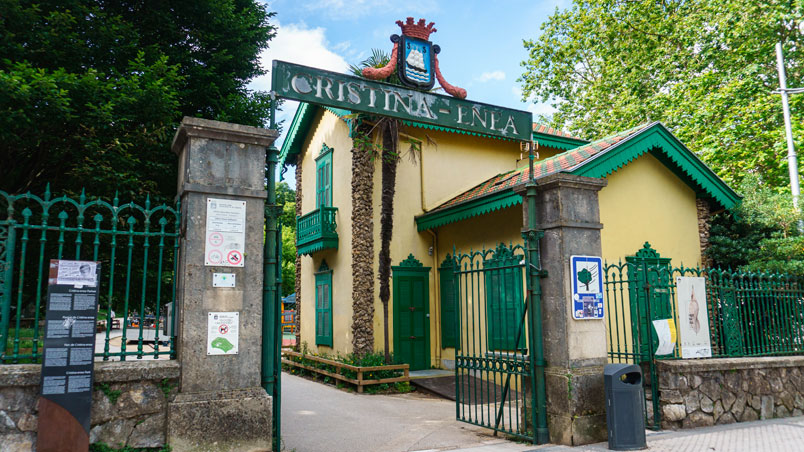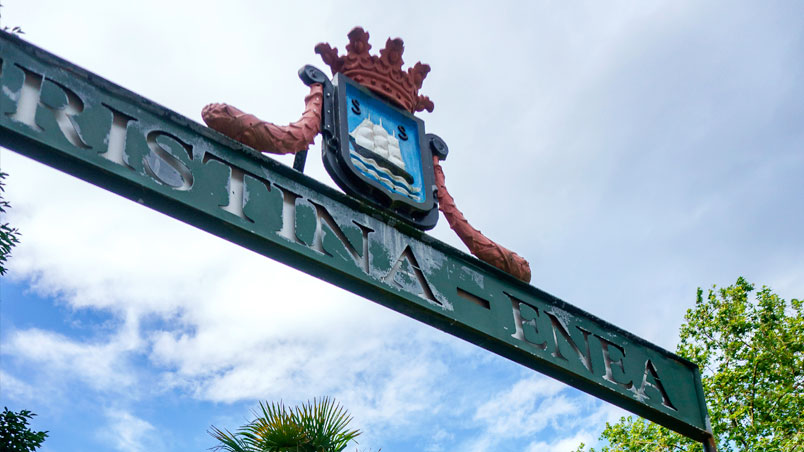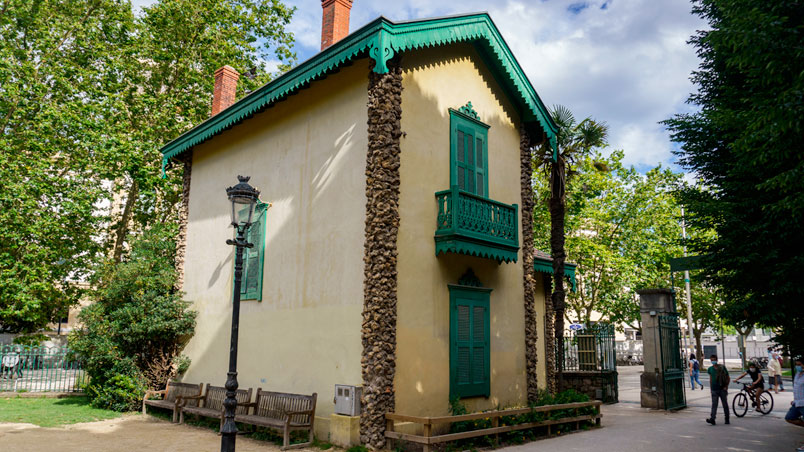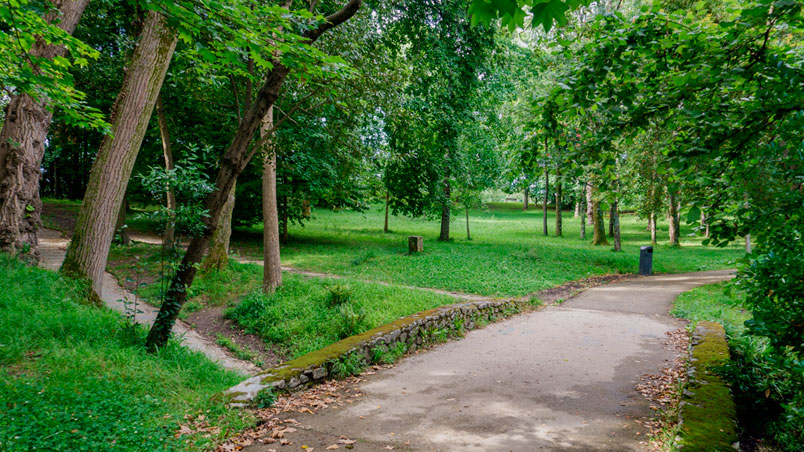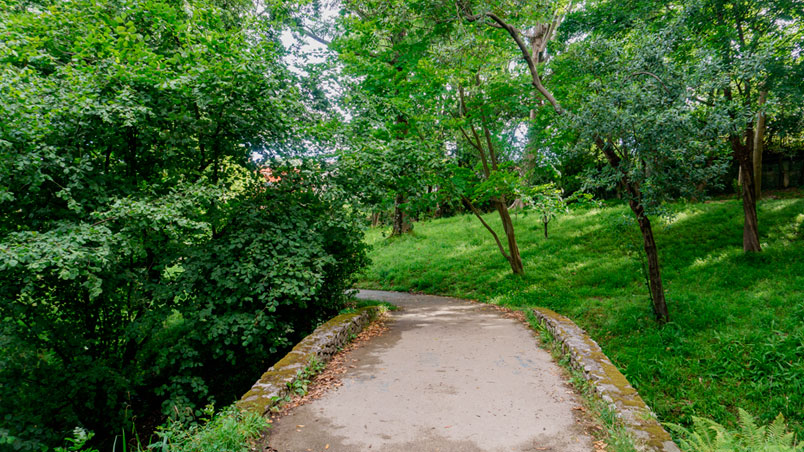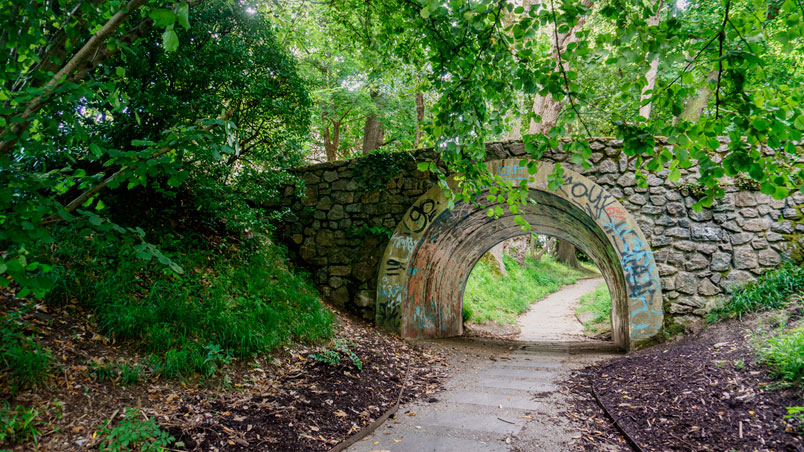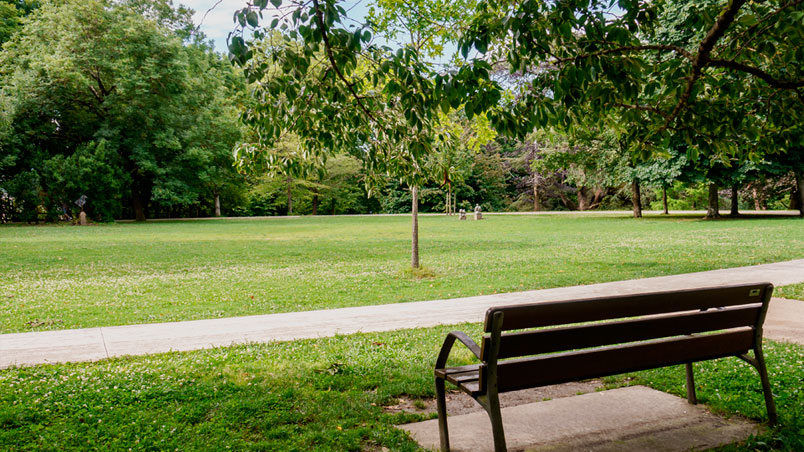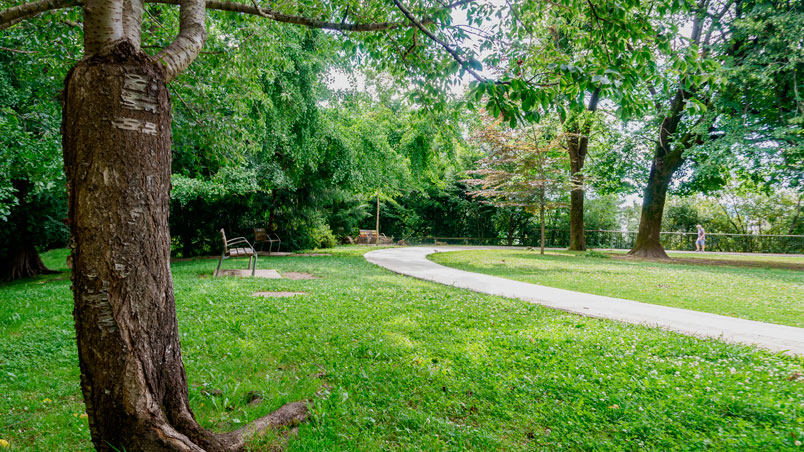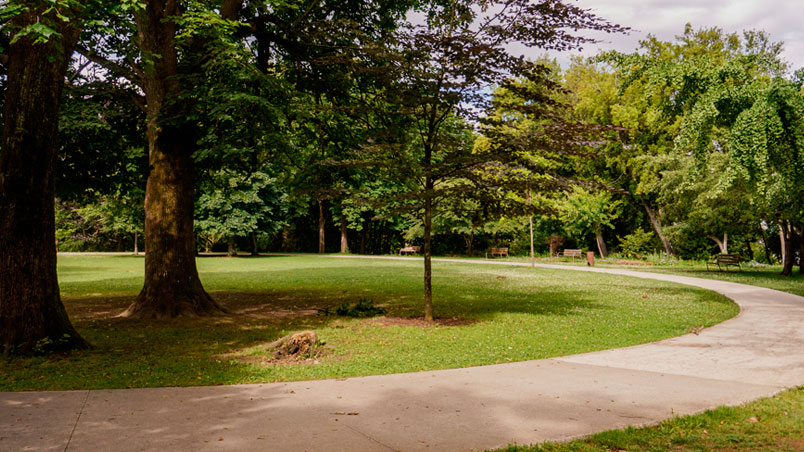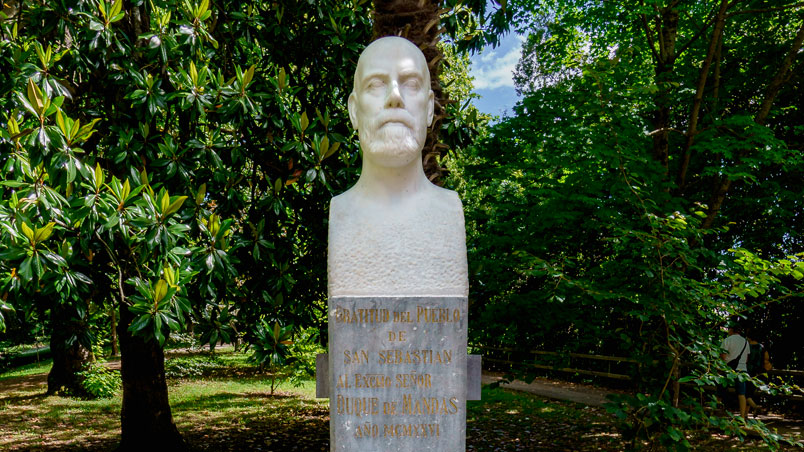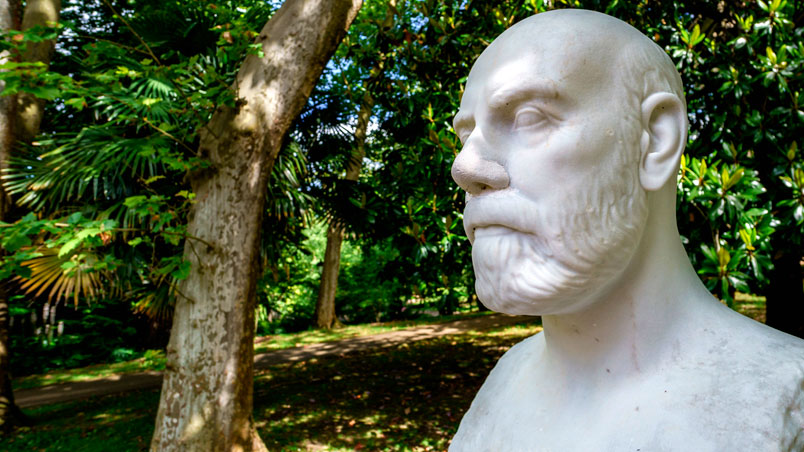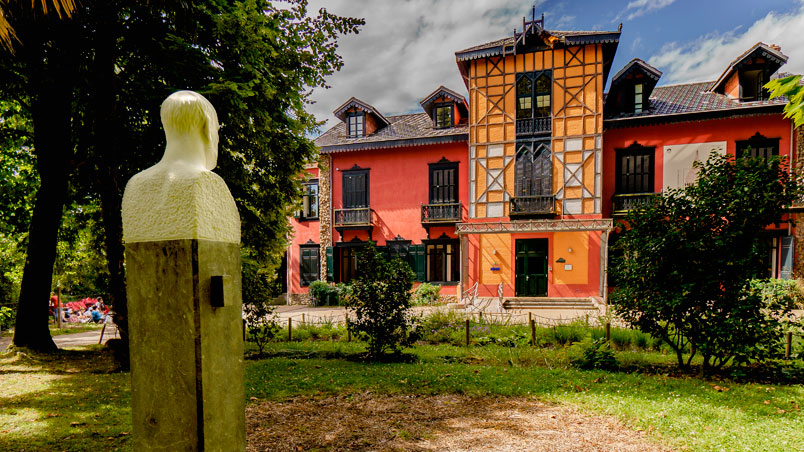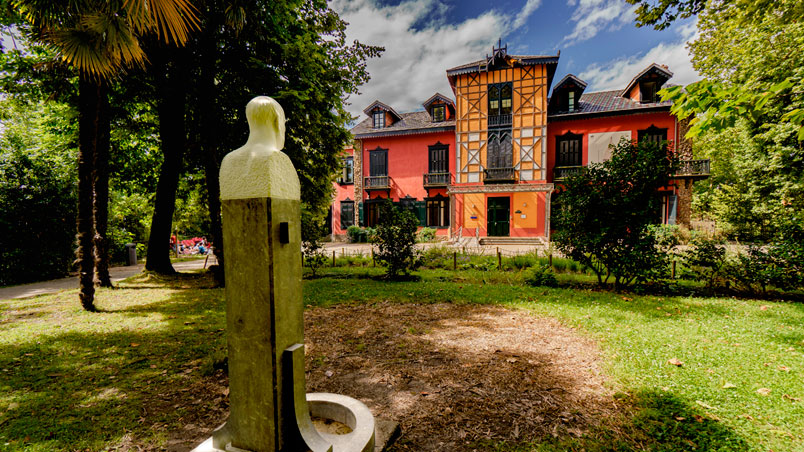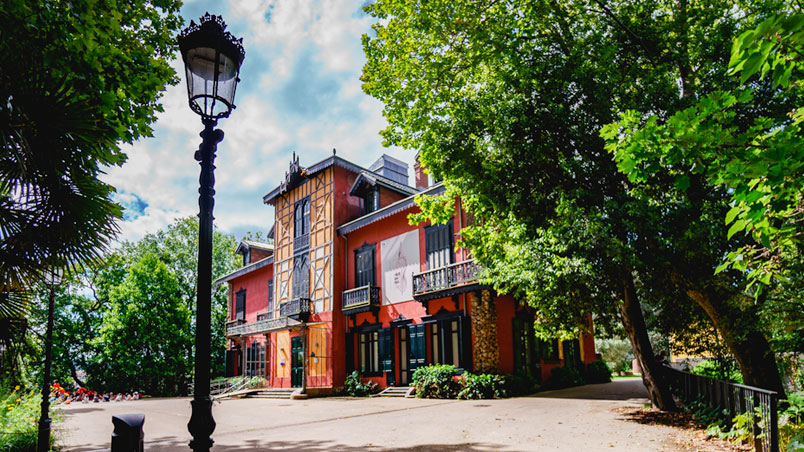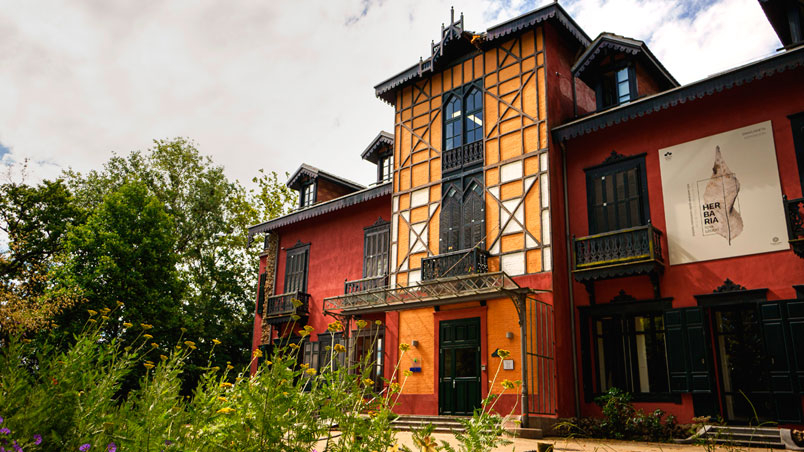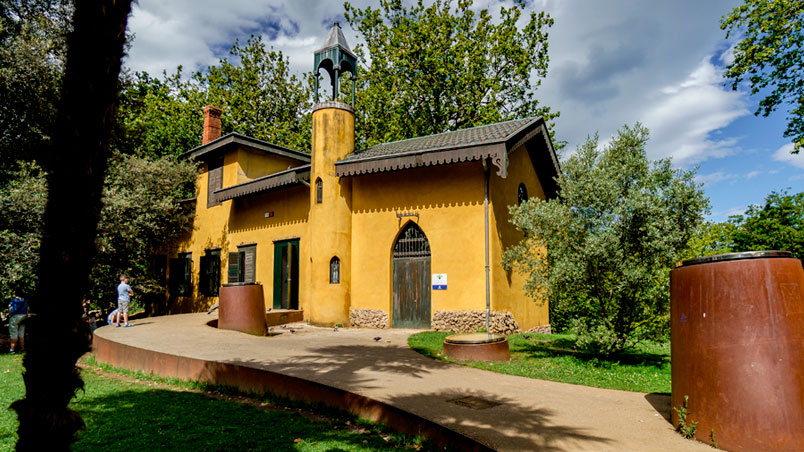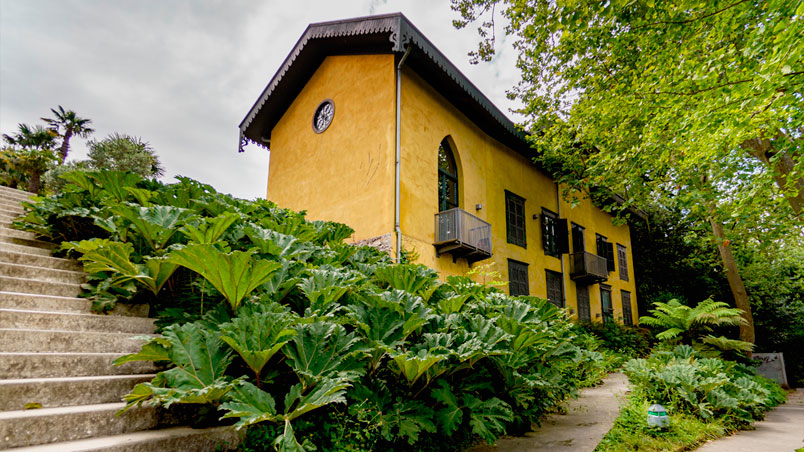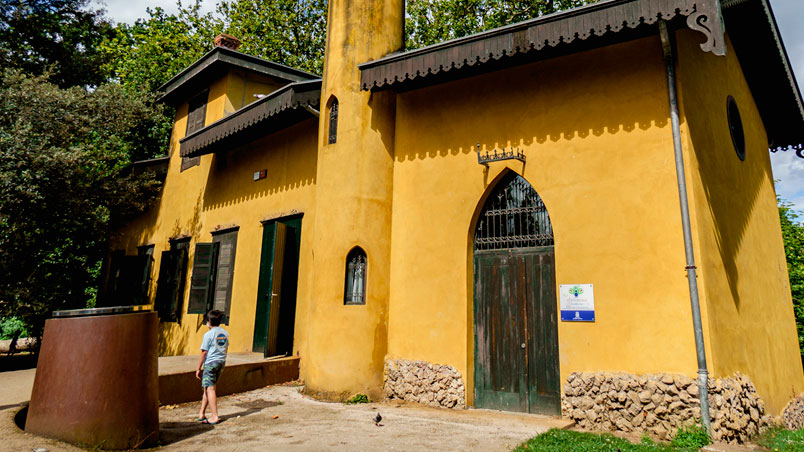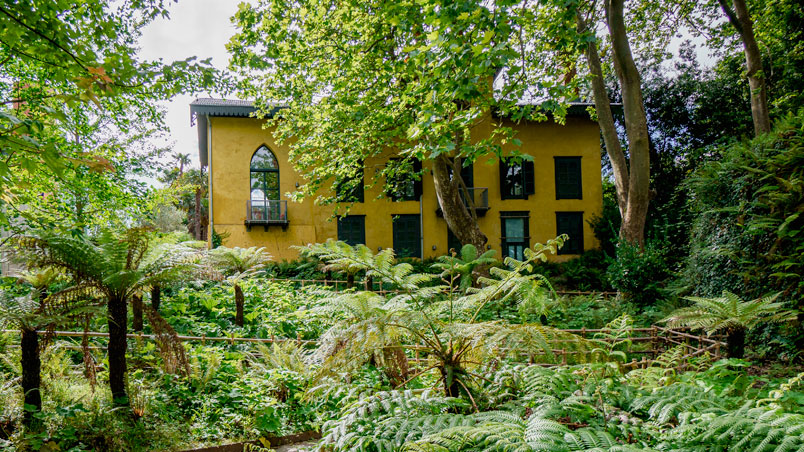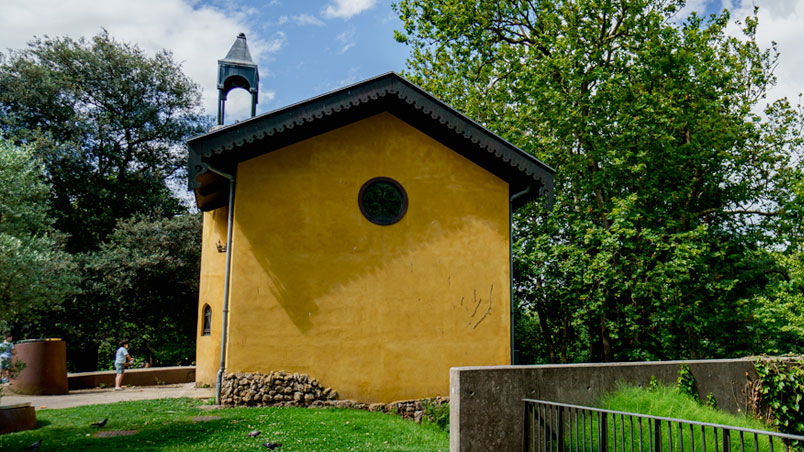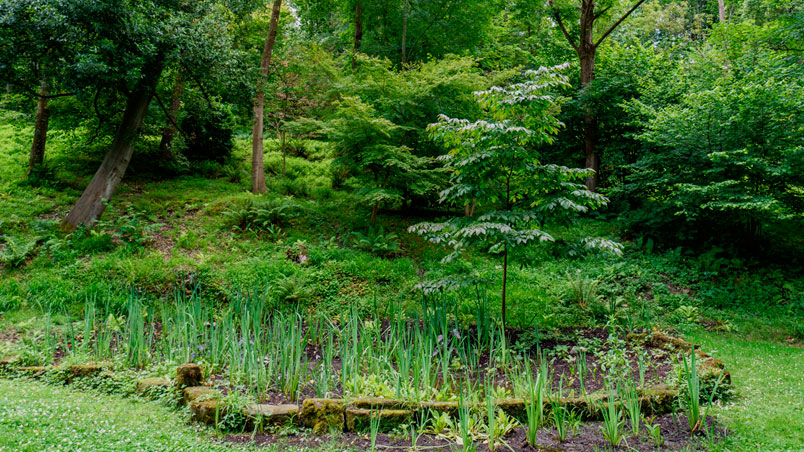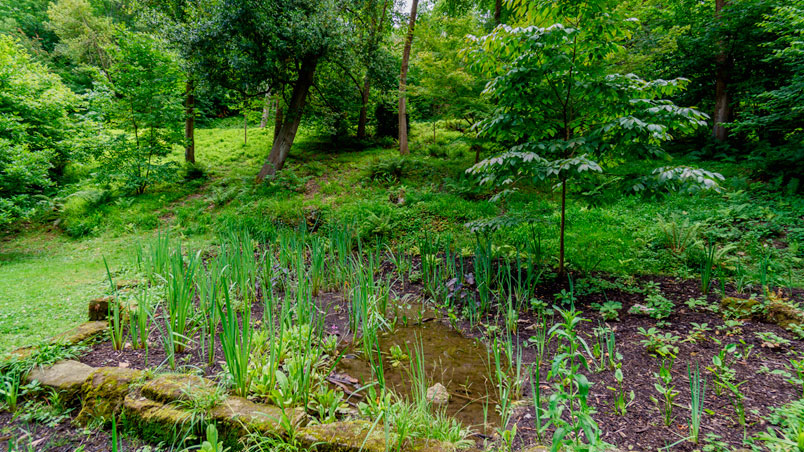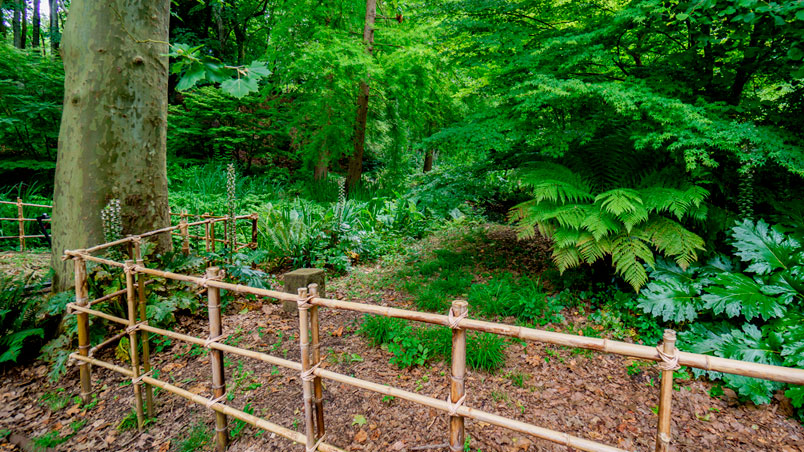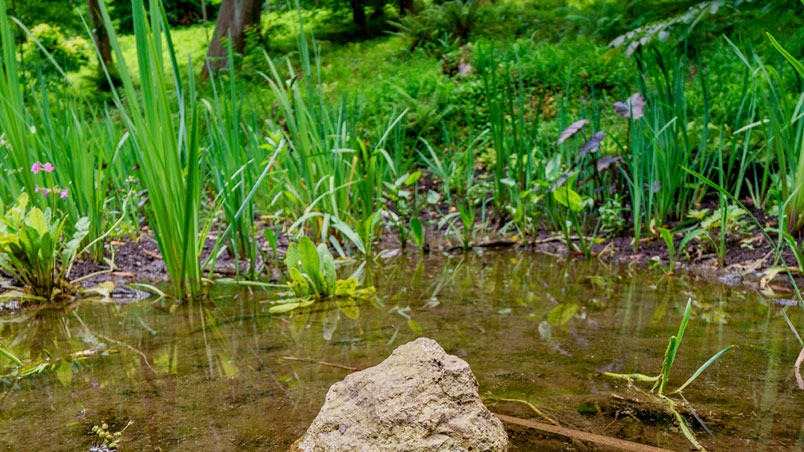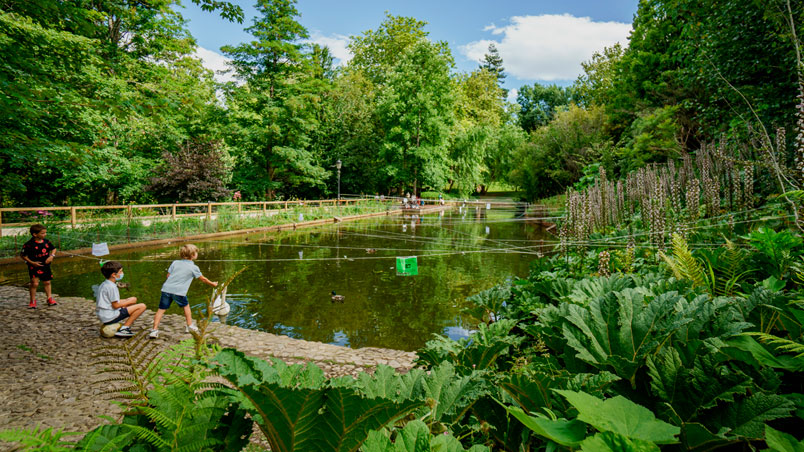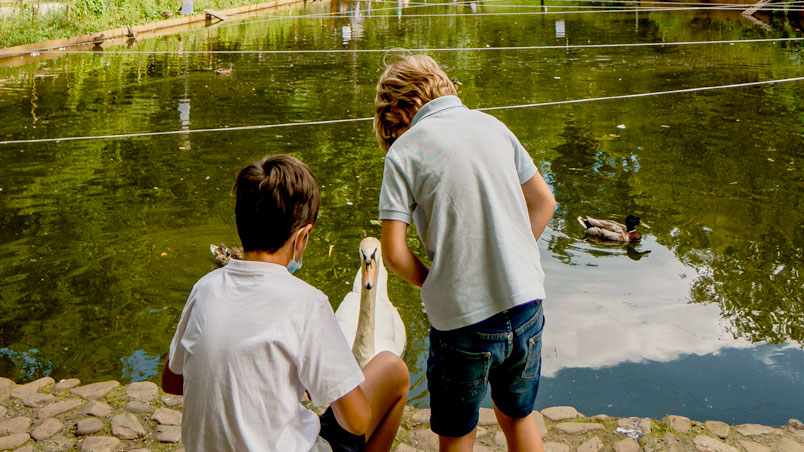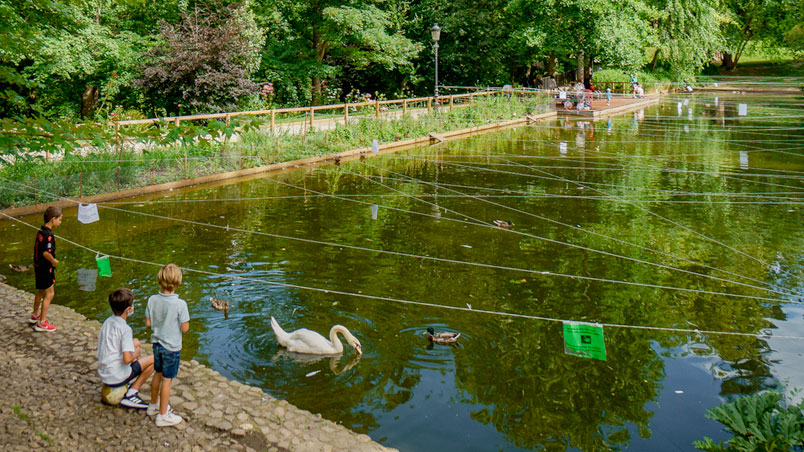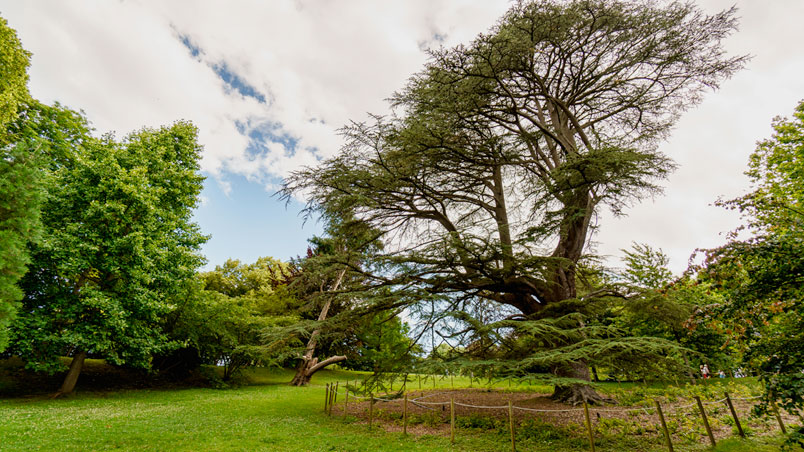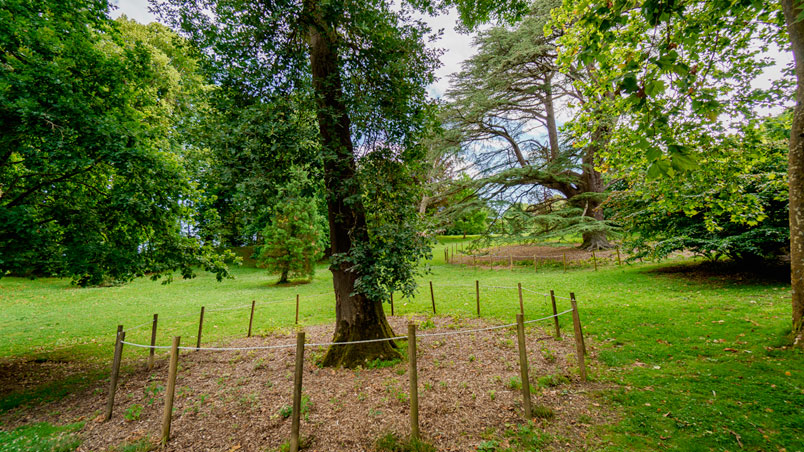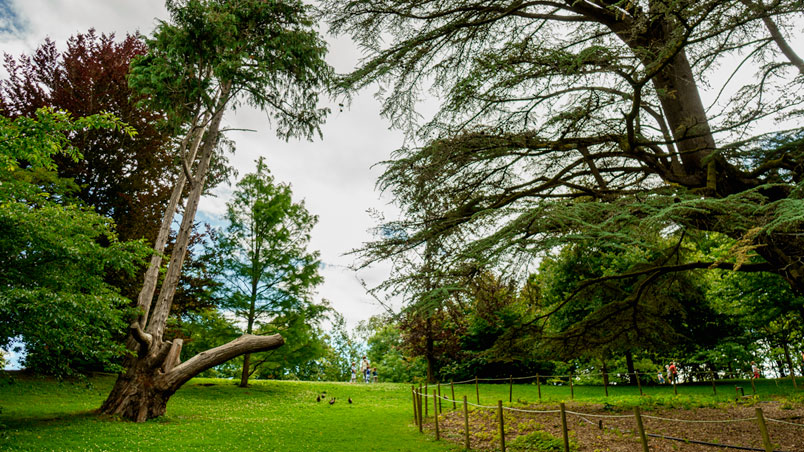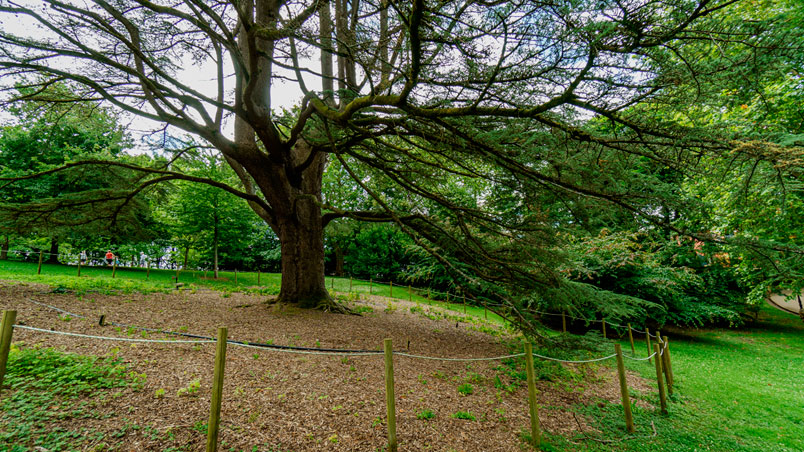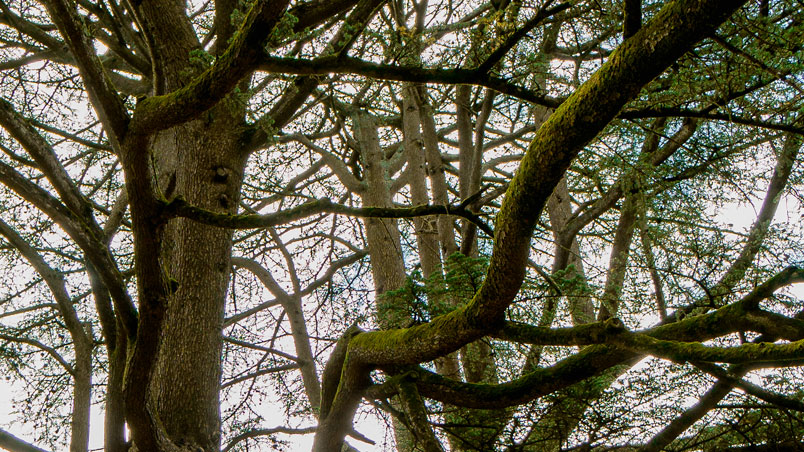Cristina Enea Park
Cristina Enea Park is Egia’s ‘green’ resident. It is the largest and most wooded urban park in the city, a gift made to San Sebastian by the Duke of Mandas (which is why it bears his wife’s name) on the condition that its original appearance was preserved. And it has been: the park still retains the charm of yesteryear, with a full network of footpaths. And in the upper area, next to the house, you can see still the peacocks that freely roam the site.
Green routes accessible and interactive

Interactive map of the route: Enjoy a pleasant tour of this magical San Sebastian park
Interactive map of the route
Select the locations
Distance
Stops
Time
- 1. Donostia at the end of the 19th century
- 2. Inheritance from the Duke and Duchess
- 3. The oval
- 4. The Duke and Duchess of Mandas
- 5. The Cristina Enea estate
- 6. The kitchens and the chapel
- 7. The pools
- 8. The pond
- 9. Conifer grove
1. Donostia at the end of the 19th century
Audioguide
Donostia at the end of the 19th century
Hello! Right now you are entering the fulfilment of a dream. The dream of a late 19th century couple: Cristina Enea; Cristina's house.
This country estate is located on a small hill created by the last bend in the Urumea River. It currently occupies almost 95,000 square metres and is the largest park in the centre of Donostia.
This estate dates back to the second half of the 19th century. It was a time of great change for our city. In 1863, the demolition of the walls surrounding what is now known as the Old Quarter was approved. This meant that the city could expand, create its ordered expansion and begin to build its new character as a modern city and capital of the Gipuzkoa province.
The Queen Regent María Cristina, widow of King Alfonso XII, chose Donostia as her summer residence, moving here to enjoy the Bay of Biscay waters and the milder climate than that of central Spain. Along with her, the entire court and government arrived and, as a consequence, wide avenues, stately homes and majestic buildings worthy of the aristocracy and high bourgeoisie of the time began to be built. Casinos, theatres, hotels, bath houses... were also erected, turning San Sebastian into an elegant and cosmopolitan city, very much in line with modern European cities at the turn of the century.
The thinking, philosophy and artistic trends of this period, halfway between the 19th and 20th centuries, extolled sentiment over reason, the presence of nature, hygienist trends, the beauty of the classical style... and all of this had an influence on the architecture, landscaping and town planning of Donostia.
"Taking the sea water" was healthy. It wasn't about going to the beach like we do today. It was more a question of health and therapeutic treatment than of leisure. For this reason, spending the summer on the coast was a trend for those in society who could afford it due to their work and financial means. Against this background, country estates and mansions were also being built in our city, which took on forms in keeping with the taste of the period: rustic, picturesque palaces... surrounded by lush, elegant and exotic parks and gardens, in an attempt to reproduce an ideal nature. And among them, Cristina Enea stands out, a picturesque-style estate created by the Duke and Duchess of Mandas where they were able to give free rein to their most romantic desires.
Continue walking through the park, until you reach the conifer grove.
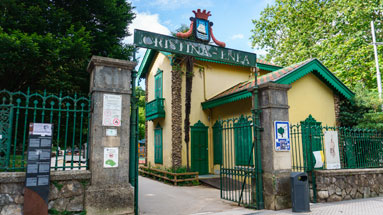
1 Donostia at the end of the 19th century
2. Inheritance from the Duke and Duchess
Audioguide
Inheritance from the Duke and Duchess
Cristina Brunetti y Gayoso de los Cobos died at Cristina Enea in 1914 at the age of 83. Her husband, Fermín Lasala y Collado, outlived her by three years, and died in Madrid in 1917 at the age of 85.The marriage was childless, so they had no one to whom they could directly bequeath their possessions. The Duke and Duchess of Mandas decided to bequeath to Gipuzkoa and their beloved Donostia what they had built during their lifetime.
The Cristina Enea estate was bequeathed to the city of Donostia, as stipulated in the will: "to provide it with a park and gardens". For a time, the siblings and nieces and nephews of the Duke and Duchess were given the right to use it but, soon after, they decided to stop using the estate and in 1926 the city took effective possession of Cristina Enea.
Even so, the Duke and Duchess left a written list of conditions to be met in order for the city to inherit the park. Among other conditions, they asked that the name of Cristina Enea should never be altered, that it should be closed every day at dusk, and that not an inch of land or a roof tile of the buildings should ever be sold, leased or exchanged... As a curious fact, they wrote that it was strictly forbidden to play any game in the park, be it with balls, football or the evil roulette wheel. In addition, Fermín also asked that the portrait of his beloved wife be transferred from his palace in Madrid to Cristina Enea, and that it be placed in a prominent position in the palace. Thus, Cristina would always be at her home, in Cristina Enea.
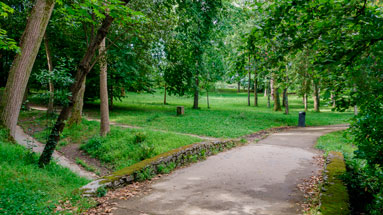
2 Inheritance from the Duke and Duchess
3. The oval
Audioguide
The oval
On this circular esplanade, in the upper part of the estate, there is a sculpture in homage to Gladys Del Estal. Gladys was a young woman from Egia, the area where Cristina Enea is located, who was committed to the environment and was part of the local ecologist and anti-nuclear group.She was also closely linked to Cristina Enea where she organised nature activities for young people. She was shot dead in 1979 in Tudela by the police during a peaceful anti-nuclear protest. After his death, the neighbourhood and the city took to the streets in a wave of protests in the Basque Country and Navarra.This sculpture in limestone by the artist Xabier Laka, made up of female figures of various sizes, was erected in her honour.
Directly in front of the sculpture, on the other side of the lane, we can see a large tree with rough bark. It is the famous Ginkgo biloba. With its curious fan-shaped leaves, it is the only species left of a family that inhabited large regions of the planet millions of years ago. A champion of endurance, this species has survived some of the worst catastrophes on the planet, from the asteroid that wiped out the dinosaurs 65 million years ago to the atomic bombing of Hiroshima. The Ginkgo biloba always endures.
As a curiosity, this species is gender-divided, i.e. some trees are female and others are male. This specimen at Cristina Enea is a female, and every autumn it produces fleshy yellowish-brown fruits, similar to small plums. These fruits contain butyric acid, which gives them a very strong and unpleasant smell. This is why most of the ornamental ginkgos planted in streets and gardens nowadays are usually male, to avoid this bad smell. In China, its medicinal use is widespread as it helps to improve blood circulation in the brain, especially for memory problems, relieving fatigue, depression and even hangovers.
The Duke and Duchess wanted a ginkgo at Cristina Enea, for which they had to pay a handsome sum. This was the species that defined the status of a country house and the family that lived there.
Continue on to the palace of Cristina Enea. Behind you there is a yellow building.
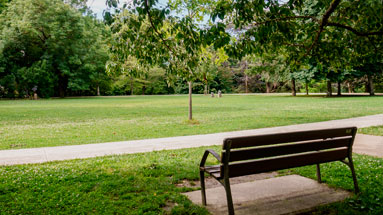
3 The oval
4. The Duke and Duchess of Mandas
Audioguide
The Duke and Duchess of Mandas
Fermín de Lasala y Collado was born in San Sebastián in 1832. His father, Fermín Lasala Urbieta, was mayor of this city and one of the driving forces behind the reconstruction and revival of Donostia after the burning and destruction in 1813, at the end of the War of Independence. He came to have great political influence both in the province and in Madrid, a fact that paved the way for his son's political career.
His mother, Rita Collado y Parada, belonged to one of the richest families in the city, great maritime entrepreneurs and merchants of Santander origin.
The future Duke of Mandas, our Fermín de Lasala y Collado, was an only son and inherited a large fortune and a wide network of contacts from his mother and father, which enabled him to rise to the highest echelons of society at the time. He became a Member of Parliament in Madrid, a Member of the Provincial Council of Gipuzkoa, Minister of various departments and ambassador to Paris and London at different times. He became all important in the political sphere at that time, with direct access to both Queen María Cristina and King Alfonso XIII, and was very close to the former president of the government, Cánovas del Castillo.
He met María Cristina Fernanda Brunetti y Gayoso de los Cobos in Madrid. She was the daughter of Lázaro Brunetti, ambassador to the Austrian Empire in Madrid, and María Josefa Gayoso y Téllez Girón, daughter of one of the most important aristocratic families of the time. It was her uncle, the powerful Duke of Osuna, who bequeathed her the title of Duchess of Mandas when he died. Not much is known about her, but what she did do was form part of the group that founded the Royal Spanish Society of Natural History, a fact that speaks volumes about her character and her interest in the study of nature. Of its 26 founding members, only three were women, including Cristina Brunetti.
In 1859, Fermín and Cristina were married in Madrid. It was the perfect union between the perfect bourgeois politician and the perfect aristocrat. He brought his political influence and she brought her aristocratic title. As soon as they were married they set off for his hometown, San Sebastian, to start their new life and join in with the custom of building themselves an estate in the court's summer resort.
Stand facing the palace of Cristina Enea.
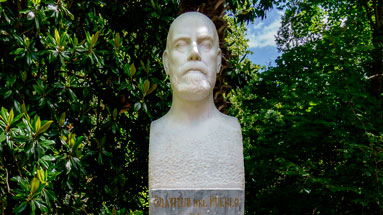
4 The Duke and Duchess of Mandas
5. The Cristina Enea estate
Audioguide
The Cristina Enea estate
The Duke and Duchess of Mandas chose some land on the last bend of the Urumea River, on the outskirts of the city. The first land they bought belonged to the Mundaiz estate, which was followed by farmhouses, vegetable gardens and a water mill by the river. A good deal of money buying it all made the estate the perfect size to build their own paradise on earth. As the plots of land were acquired, the estate was designed according to the taste of the time and that of the couple. Lanes, copses, trees, the pond... these were the first things to be designed and built, even before the palace or the service buildings. To achieve this, they hired some of the best architects and landscape designers of the time, such as the gardener Lecour, the Parisian landscape designer Georges Aumont and the famous gardener Pierre Ducasse.
The main building in the park, the palace, was designed by José Clemente de Osinalde, a great architect and confidant of the Duke. Initially it consisted only of a ground floor and a loft, but over time a first floor was added, as well as an extra wing on one of the sides, until it acquired its current appearance.
It was in this picturesque style palace where the Duke and Duchess made their summer residence and where many great political, military and religious personalities of the time visited. The beloved estate of the Duke and Duchess of Mandas, Cristina Enea, became one of the most admired and visited due to its size, design and rich landscape.
The old palace currently houses the Cristina Enea Environmental Resource Centre, where we can find exhibition rooms and a documentation centre.It is also the headquarters of the Foundation that bears its name, which is dedicated to environmental awareness and education.
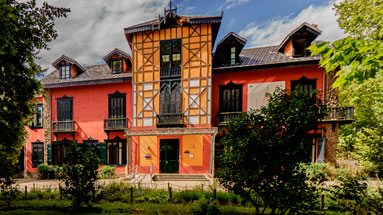
5 The Cristina Enea estate
6. The kitchens and the chapel
Audiogudide
The kitchens and the chapel
Shortly after the mansion was built, a new building was constructed separate from the main building. This is where the kitchens were installed. t was quite common for fires to break out in the kitchens so, to avoid burning down the main building, moving the kitchens to another building was the best option.
The curious thing is that, in order to take the food to the palace dining room, an underground passageway was built, connecting the two buildings.Thus, there was no need to walk around the estate with the food.
A little later, a small chapel was added to the kitchen building, where the Duke and Duchess could attend mass without leaving their estate.
The Duke and Duchess enjoyed Cristina Enea as much time as they could. Fermín's political obligations in Madrid, London and Paris meant that he was separated from Cristina for long periods.he also travelled around the country to her various estates or palaces, making communication between the two difficult. But it is here that we see Fermín's astuteness once again.
Fermín promoted the connection of the railway to France through Donostia and to have the station next to his lands. His strategic vision made it possible for them to have the station of the main communication route at that time practically at the entrance to their estate.
The mail arrived by train from Madrid or Paris every day to San Sebastián, which meant that the couple corresponded daily during the times when they were separated.The letters that Cristina received from Fermín from wherever he was have been preserved, and in them we can follow the works at Cristina Enea, the love that the couple had for each other and the great affection that they had for Cristina Enea.
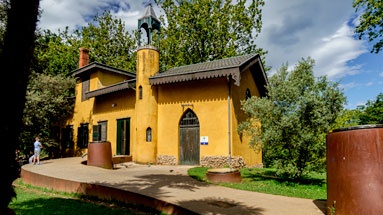
6 The kitchens and the chapel
7. The pools
Audioguide
The pools
This spot is one of the most unique and magical places in the park and also one of the least known.
It is a group of small artificial pools that were built to imitate natural ones. At the bottom they are waterproofed with natural materials and the water they contain is rainwater collected in the park itself. These freshwater habitats are very important for the amphibians to complete their life cycle and they also provide water for the other animals in the park.
In the small hidden woodland surrounding the pools, we can find the Japanese maple, with its star-shaped leaves, which turn a beautiful red colour in autumn. We can also see the Alocasia, an evergreen plant, also known as "elephant's ear" as its main feature is its large arrow-shaped leaves that resemble the ears of an elephant.
This area is where the park's amphibians breed, such as the common toad, the common grass frog and the common midwife toad.Due to the disappearance of wetlands, amphibians are the world's fastest disappearing vertebrates.Therefore, maintaining this habitat becomes even more important.
A curious fact: the male midwife toad found in Cristina Enea carries the fertilised eggs between its hind legs for a month, from the time they are laid until they hatch. This is an atypical and fascinating behaviour in the animal kingdom, males taking care of fertilised eggs, their sons and daughters.
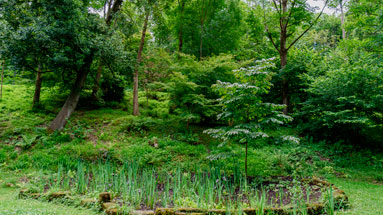
7 The pools
8. The pond
Audioguide
The pond
This area of Cristina Enea is probably the most well-known in the park. Of course, it is the most visited and it is where the ducks, swans and peacocks that reside in Cristina Enea can be seen.
Peacocks are birds known for their large tails and striking colours. But it's important to know that not all of them have those famous tails, nor do they always look so beautiful. Those bright colours with which we identify them are nothing more than the male's courtship attire. They grow their majestic tails in spring, which they open in order to call and attract females and show off their bright, blue colours. But in mid-summer the long tail feathers start to fall off and disappear completely until the following year. Females, on the other hand, have a more subdued, brownish plumage, which helps them to camouflage themselves, an aspect that is very useful during the breeding season.
In addition to the peacocks, there are also more discreet and less glamorous animals in Cristina Enea, but no less interesting nonetheless, as they contribute to increasing the park's biodiversity. One of them is the Stag beetle, Europe's largest beetle. This beetle, which can grow up to 9 centimetres in length, needs old trees to live, as the females lay their eggs under their bark. In Cristina Enea we know that they use the old oak trees in the park. Males are larger than females and have much more developed jaws, which are very useful for fighting.
They are shaped like the horns of a deer, hence the insect's common name.
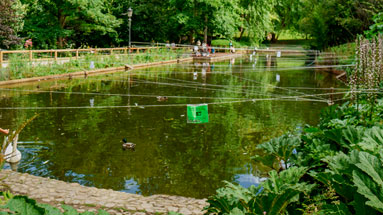
8 The pond
9. Conifer grove
Audioguide
Conifer grove
In these extensive gardens, together with the native species, we can find trees of extraordinary size and beauty, from all five continents. Some of them can be found in this very meadow.
It is one of the most beautiful corners of the park, where we can see a Lebanese Cedar, a Lawson cypress and different types of sequoias.
Nowadays the ornamental use of plants from other countries is widespread, but in the second half of the 19th century, when Cristina Enea was created, it was quite exceptional to be able to enjoy species from exotic places.
The Duke and Duchess of Mandas wanted to bring plants from all over the world to Cristina Enea that could only be known by travelling thousands of kilometres. This practice demonstrated their financial power, as it was neither easy nor cheap to obtain non-native species.
The enormous tree that presides over this meadow is a Lebanese cedar and is one of the oldest trees in Cristina Enea. It is also one of the largest, measuring some 30 metres in height.
This cedar has lost the characteristic cone shape of the Lebanese cedars, indicating that it has reached its maximum height and has stopped growing. Its needle-shaped leaves vary in colour from dark green to bluish-green. Its fruits are characteristically barrel-shaped and consist of flattened scales with a purplish edge, often resinous.
Due to the quality of its strong, durable wood, the Lebanese cedar forests have been exploited since ancient times. The Egyptians used its wood for their huge constructions and the oil from its leaves to embalm mummies. It is the national tree of the Lebanon, in the Middle East, and its silhouette appears on the Lebanese flag.
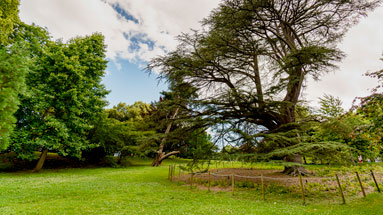
9 Conifer grove
Watch video
The Cristina Enea Park conceals a beautiful story featuring its former owners Fermín and Cristina, Duke and Duchess of Mandas. This influential couple formed part of the bourgeoisie of San Sebastian at the end of the 19th century and Cristina Enea, their beloved summer estate, became one of the most admired and visited properties due to its design and beautiful landscape.
In this stroll through the park, we will recall how "Cristina's house" was built and we will discover some of its most special features.
